Lin Qiu
Paul G. Allen School of Computer Science & Engineering, University of Washington, United States
Deepfake-Eval-2024: A Multi-Modal In-the-Wild Benchmark of Deepfakes Circulated in 2024
Mar 05, 2025Abstract:In the age of increasingly realistic generative AI, robust deepfake detection is essential for mitigating fraud and disinformation. While many deepfake detectors report high accuracy on academic datasets, we show that these academic benchmarks are out of date and not representative of real-world deepfakes. We introduce Deepfake-Eval-2024, a new deepfake detection benchmark consisting of in-the-wild deepfakes collected from social media and deepfake detection platform users in 2024. Deepfake-Eval-2024 consists of 45 hours of videos, 56.5 hours of audio, and 1,975 images, encompassing the latest manipulation technologies. The benchmark contains diverse media content from 88 different websites in 52 different languages. We find that the performance of open-source state-of-the-art deepfake detection models drops precipitously when evaluated on Deepfake-Eval-2024, with AUC decreasing by 50\% for video, 48\% for audio, and 45\% for image models compared to previous benchmarks. We also evaluate commercial deepfake detection models and models finetuned on Deepfake-Eval-2024, and find that they have superior performance to off-the-shelf open-source models, but do not yet reach the accuracy of deepfake forensic analysts. The dataset is available at https://github.com/nuriachandra/Deepfake-Eval-2024.
Contextualizing biological perturbation experiments through language
Feb 28, 2025Abstract:High-content perturbation experiments allow scientists to probe biomolecular systems at unprecedented resolution, but experimental and analysis costs pose significant barriers to widespread adoption. Machine learning has the potential to guide efficient exploration of the perturbation space and extract novel insights from these data. However, current approaches neglect the semantic richness of the relevant biology, and their objectives are misaligned with downstream biological analyses. In this paper, we hypothesize that large language models (LLMs) present a natural medium for representing complex biological relationships and rationalizing experimental outcomes. We propose PerturbQA, a benchmark for structured reasoning over perturbation experiments. Unlike current benchmarks that primarily interrogate existing knowledge, PerturbQA is inspired by open problems in perturbation modeling: prediction of differential expression and change of direction for unseen perturbations, and gene set enrichment. We evaluate state-of-the-art machine learning and statistical approaches for modeling perturbations, as well as standard LLM reasoning strategies, and we find that current methods perform poorly on PerturbQA. As a proof of feasibility, we introduce Summer (SUMMarize, retrievE, and answeR, a simple, domain-informed LLM framework that matches or exceeds the current state-of-the-art. Our code and data are publicly available at https://github.com/genentech/PerturbQA.
Leveraging Dual Process Theory in Language Agent Framework for Real-time Simultaneous Human-AI Collaboration
Feb 17, 2025Abstract:Agents built on large language models (LLMs) have excelled in turn-by-turn human-AI collaboration but struggle with simultaneous tasks requiring real-time interaction. Latency issues and the challenge of inferring variable human strategies hinder their ability to make autonomous decisions without explicit instructions. Through experiments with current independent System 1 and System 2 methods, we validate the necessity of using Dual Process Theory (DPT) in real-time tasks. We propose DPT-Agent, a novel language agent framework that integrates System 1 and System 2 for efficient real-time simultaneous human-AI collaboration. DPT-Agent's System 1 uses a Finite-state Machine (FSM) and code-as-policy for fast, intuitive, and controllable decision-making. DPT-Agent's System 2 integrates Theory of Mind (ToM) and asynchronous reflection to infer human intentions and perform reasoning-based autonomous decisions. We demonstrate the effectiveness of DPT-Agent through further experiments with rule-based agents and human collaborators, showing significant improvements over mainstream LLM-based frameworks. To the best of our knowledge, DPT-Agent is the first language agent framework that achieves successful real-time simultaneous human-AI collaboration autonomously. Code of DPT-Agent can be found in https://github.com/sjtu-marl/DPT-Agent.
Learning Identifiable Factorized Causal Representations of Cellular Responses
Oct 29, 2024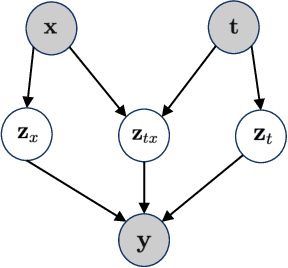

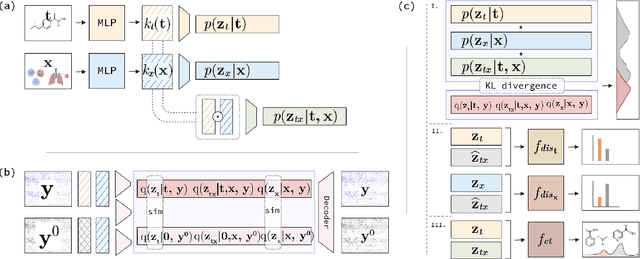

Abstract:The study of cells and their responses to genetic or chemical perturbations promises to accelerate the discovery of therapeutic targets. However, designing adequate and insightful models for such data is difficult because the response of a cell to perturbations essentially depends on its biological context (e.g., genetic background or cell type). For example, while discovering therapeutic targets, one may want to enrich for drugs that specifically target a certain cell type. This challenge emphasizes the need for methods that explicitly take into account potential interactions between drugs and contexts. Towards this goal, we propose a novel Factorized Causal Representation (FCR) learning method that reveals causal structure in single-cell perturbation data from several cell lines. Based on the framework of identifiable deep generative models, FCR learns multiple cellular representations that are disentangled, comprised of covariate-specific ($\mathbf{z}_x$), treatment-specific ($\mathbf{z}_{t}$), and interaction-specific ($\mathbf{z}_{tx}$) blocks. Based on recent advances in non-linear ICA theory, we prove the component-wise identifiability of $\mathbf{z}_{tx}$ and block-wise identifiability of $\mathbf{z}_t$ and $\mathbf{z}_x$. Then, we present our implementation of FCR, and empirically demonstrate that it outperforms state-of-the-art baselines in various tasks across four single-cell datasets.
ECon: On the Detection and Resolution of Evidence Conflicts
Oct 05, 2024



Abstract:The rise of large language models (LLMs) has significantly influenced the quality of information in decision-making systems, leading to the prevalence of AI-generated content and challenges in detecting misinformation and managing conflicting information, or "inter-evidence conflicts." This study introduces a method for generating diverse, validated evidence conflicts to simulate real-world misinformation scenarios. We evaluate conflict detection methods, including Natural Language Inference (NLI) models, factual consistency (FC) models, and LLMs, on these conflicts (RQ1) and analyze LLMs' conflict resolution behaviors (RQ2). Our key findings include: (1) NLI and LLM models exhibit high precision in detecting answer conflicts, though weaker models suffer from low recall; (2) FC models struggle with lexically similar answer conflicts, while NLI and LLM models handle these better; and (3) stronger models like GPT-4 show robust performance, especially with nuanced conflicts. For conflict resolution, LLMs often favor one piece of conflicting evidence without justification and rely on internal knowledge if they have prior beliefs.
Toward a More Complete OMR Solution
Aug 31, 2024Abstract:Optical music recognition (OMR) aims to convert music notation into digital formats. One approach to tackle OMR is through a multi-stage pipeline, where the system first detects visual music notation elements in the image (object detection) and then assembles them into a music notation (notation assembly). Most previous work on notation assembly unrealistically assumes perfect object detection. In this study, we focus on the MUSCIMA++ v2.0 dataset, which represents musical notation as a graph with pairwise relationships among detected music objects, and we consider both stages together. First, we introduce a music object detector based on YOLOv8, which improves detection performance. Second, we introduce a supervised training pipeline that completes the notation assembly stage based on detection output. We find that this model is able to outperform existing models trained on perfect detection output, showing the benefit of considering the detection and assembly stages in a more holistic way. These findings, together with our novel evaluation metric, are important steps toward a more complete OMR solution.
RAGChecker: A Fine-grained Framework for Diagnosing Retrieval-Augmented Generation
Aug 15, 2024



Abstract:Despite Retrieval-Augmented Generation (RAG) has shown promising capability in leveraging external knowledge, a comprehensive evaluation of RAG systems is still challenging due to the modular nature of RAG, evaluation of long-form responses and reliability of measurements. In this paper, we propose a fine-grained evaluation framework, RAGChecker, that incorporates a suite of diagnostic metrics for both the retrieval and generation modules. Meta evaluation verifies that RAGChecker has significantly better correlations with human judgments than other evaluation metrics. Using RAGChecker, we evaluate 8 RAG systems and conduct an in-depth analysis of their performance, revealing insightful patterns and trade-offs in the design choices of RAG architectures. The metrics of RAGChecker can guide researchers and practitioners in developing more effective RAG systems.
OpenResearcher: Unleashing AI for Accelerated Scientific Research
Aug 13, 2024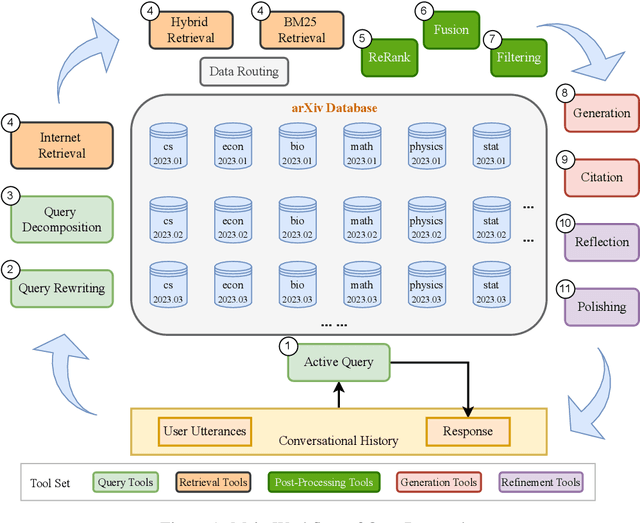

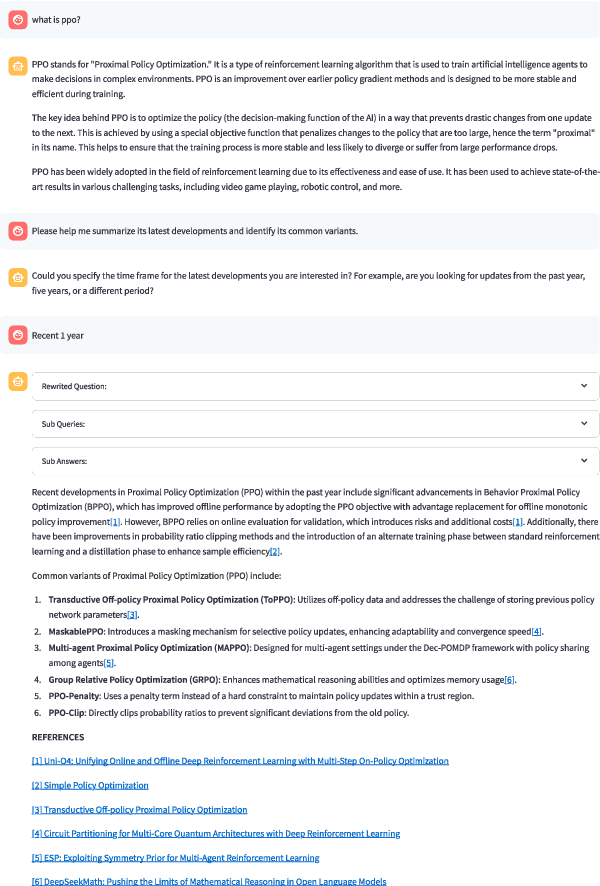
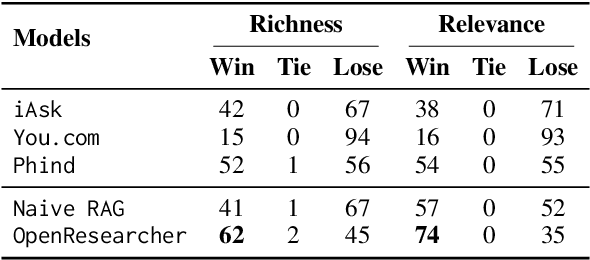
Abstract:The rapid growth of scientific literature imposes significant challenges for researchers endeavoring to stay updated with the latest advancements in their fields and delve into new areas. We introduce OpenResearcher, an innovative platform that leverages Artificial Intelligence (AI) techniques to accelerate the research process by answering diverse questions from researchers. OpenResearcher is built based on Retrieval-Augmented Generation (RAG) to integrate Large Language Models (LLMs) with up-to-date, domain-specific knowledge. Moreover, we develop various tools for OpenResearcher to understand researchers' queries, search from the scientific literature, filter retrieved information, provide accurate and comprehensive answers, and self-refine these answers. OpenResearcher can flexibly use these tools to balance efficiency and effectiveness. As a result, OpenResearcher enables researchers to save time and increase their potential to discover new insights and drive scientific breakthroughs. Demo, video, and code are available at: https://github.com/GAIR-NLP/OpenResearcher.
The Tug-of-War Between Deepfake Generation and Detection
Jul 08, 2024
Abstract:Multimodal generative models are rapidly evolving, leading to a surge in the generation of realistic video and audio that offers exciting possibilities but also serious risks. Deepfake videos, which can convincingly impersonate individuals, have particularly garnered attention due to their potential misuse in spreading misinformation and creating fraudulent content. This survey paper examines the dual landscape of deepfake video generation and detection, emphasizing the need for effective countermeasures against potential abuses. We provide a comprehensive overview of current deepfake generation techniques, including face swapping, reenactment, and audio-driven animation, which leverage cutting-edge technologies like generative adversarial networks and diffusion models to produce highly realistic fake videos. Additionally, we analyze various detection approaches designed to differentiate authentic from altered videos, from detecting visual artifacts to deploying advanced algorithms that pinpoint inconsistencies across video and audio signals. The effectiveness of these detection methods heavily relies on the diversity and quality of datasets used for training and evaluation. We discuss the evolution of deepfake datasets, highlighting the importance of robust, diverse, and frequently updated collections to enhance the detection accuracy and generalizability. As deepfakes become increasingly indistinguishable from authentic content, developing advanced detection techniques that can keep pace with generation technologies is crucial. We advocate for a proactive approach in the "tug-of-war" between deepfake creators and detectors, emphasizing the need for continuous research collaboration, standardization of evaluation metrics, and the creation of comprehensive benchmarks.
Boosting Scientific Concepts Understanding: Can Analogy from Teacher Models Empower Student Models?
Jun 17, 2024



Abstract:Analogical reasoning plays a critical role in human cognition, enabling us to understand new concepts by associating them with familiar ones. Previous research in the AI community has mainly focused on identifying and generating analogies and then examining their quality under human evaluation, which overlooks the practical application of these analogies in real-world settings. Inspired by the human education process, in this paper, we propose to investigate how analogies created by teacher language models (LMs) can assist student LMs in understanding scientific concepts, thereby aligning more closely with practical scenarios. Our results suggest that free-form analogies can indeed aid LMs in understanding concepts. Additionally, analogies generated by student LMs can improve their own performance on scientific question answering, demonstrating their capability to use analogies for self-learning new knowledge. Resources are available at https://github.com/siyuyuan/SCUA.
 Add to Chrome
Add to Chrome Add to Firefox
Add to Firefox Add to Edge
Add to Edge